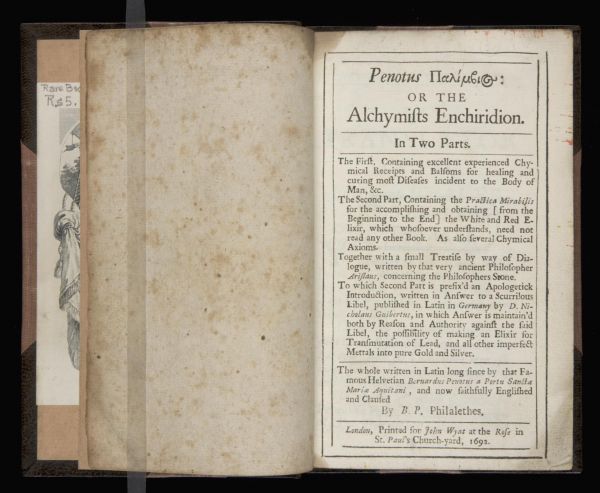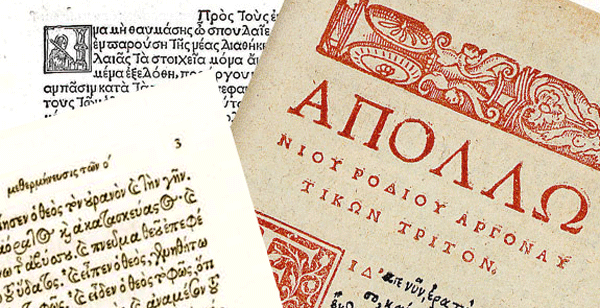| Author | Post |
|---|
Alan Pritchard
Guest
| Joined: | |
| Location: | |
| Posts: | |
| Status: |
Offline
|
|
Posted: Thu Jul 29th, 2010 03:20 pm |
|
Re: ESTC R25029 Penot, B.G. Penotus palimeis
There are some interesting discrepancies in the transliteration of the Greek word in the title page
The last character and last-but-one character in the Greek are curious, and there seem to be differing interpretations of what they are.
ESTC has 'Palimeis'
Yale's Beiecke Library catalog has 'Palimbios' (as well as another record with Palimeis - but the latter is from EEBO & hence links back to ESTC, I think)
Duveen's Bibliotheca alchemica has 'Palimosis'
My 1st edition has 'Palimosis' (I suspect this has come from Duveen)
Ferguson & the Manly P Hall catalog do not have the book.
I don't have a copy of the Mellon Collection catalog to check it against that.
What are the views on the meaning of the last and last-but- one characters. My guess is that the printer ran out of Greek letters & used what he thought were the nearest.
.jpg (courtesy of Beinecke Library) attachedAttached Image (viewed 655 times):

|
Paul Ferguson
Member

| Joined: | Fri Feb 15th, 2008 |
| Location: | |
| Posts: | 1538 |
| Status: |
Offline
|
|
Posted: Thu Jul 29th, 2010 06:01 pm |
|
At least 'palimbios' makes some sort of sense, = 'living again' or 'rediviva', whereas I cannot think what 'palimeis' or 'palimosis' might mean.
The final squiggle looks a bit like the symbol that Thompson says is sometimes used to represent the ending ῆς:
http://www.archive.org/stream/greeklatin00thomuoft#page/82/mode/2up
see page 83, line 7,
though that would give a word 'palimbiēs', which does not seem to occur.
I think your printer's kludge theory is the likeliest explanation.
|
Alan Pritchard
Guest
| Joined: | |
| Location: | |
| Posts: | |
| Status: |
Offline
|
|
Posted: Fri Jul 30th, 2010 09:33 am |
|
Thanks, as always, Paul.
It certainly does look like that character in Thompson. Which would make the word something like
Palim?ies
The ? is for the spectacle-like symbol, which could be a replacement for a beta, I suppose, which makes it Palimbies.
The only other thing that I can think of is that the last character could be viewed as as 'os' rather than the one in Thompson, which would tie in with Duveen.
I think that I will stick with the Duveen version in the bibliography, but make a note about the title page, about the odd characters.
|
Alan Pritchard
Guest
| Joined: | |
| Location: | |
| Posts: | |
| Status: |
Offline
|
|
Posted: Fri Jul 30th, 2010 10:49 am |
|
I have now received the following message back from ESTC:
"Thank you for your feedback. I have corrected the note and, after consulted with a colleague, the Beinecke transliteration is correct "palimbios", essentially a sigma within an omicron. I note also that both the BL's online catalogue and Wing give the word in a "spelt out"
form - "omicron sigma". I have corrected the ESTC record accordingly"
So I hope that settles it. The reference to the note was that it originally said that the first 2 words were Greek.
|
Paul Ferguson
Member

| Joined: | Fri Feb 15th, 2008 |
| Location: | |
| Posts: | 1538 |
| Status: |
Offline
|
|
Posted: Fri Jul 30th, 2010 10:51 am |
|
Hi Alan,
As you say, the other character is not clear either. Likeliest candidates apart from beta are delta and zeta, but neither of those produces a comprehensible word.
As for 'palimbios', it does not seem to occur in Classical Greek, but is found in later writers:
http://www.stoa.org/sol-bin//search.pl?search_method=QUERY&login=&enlogin=&searchstr=pi,86&field=adlerhw_gr&db=REAL
And it would seem that even modern Greeks like their spectacle-shaped betas:
http://raissaki.gr/pages/greektypeforum.html
I wonder if Natasha Raissaki could shed any light? Her e-mail is natasha[at]raissaki[dot]gr Attached Image (viewed 681 times):
 Last edited on Fri Jul 30th, 2010 11:13 am by Paul Ferguson
|
Paul Ferguson
Member

| Joined: | Fri Feb 15th, 2008 |
| Location: | |
| Posts: | 1538 |
| Status: |
Offline
|
|
Posted: Fri Jul 30th, 2010 10:56 am |
|
Alan Pritchard wrote:
I have now received the following message back from ESTC:
"Thank you for your feedback. I have corrected the note and, after consulted with a colleague, the Beinecke transliteration is correct "palimbios", essentially a sigma within an omicron. I note also that both the BL's online catalogue and Wing give the word in a "spelt out"
form - "omicron sigma". I have corrected the ESTC record accordingly"
So I hope that settles it. The reference to the note was that it originally said that the first 2 words were Greek.
Yes, that would certainly seem to be the likeliest explanation.
|
Paul Ferguson
Member

| Joined: | Fri Feb 15th, 2008 |
| Location: | |
| Posts: | 1538 |
| Status: |
Offline
|
|
Posted: Fri Jul 30th, 2010 11:09 am |
|
Do you have these references also:
http://books.google.com/books?id=sh3OW893K50C&pg=RA1-PA743&lpg=RA1-PA743&dq=penotus+enchiridion&source=bl&ots=V5uryLHUqR&sig=Zy-719OQd5jFFzauOD-px-xz6w4&hl=en&ei=QaRSTJOsFNO4jAf12JDEBA&sa=X&oi=book_result&ct=result&resnum=1&ved=0CBEQ6AEwADgK#v=onepage&q=penotus%20enchiridion&f=false
http://classify.oclc.org/classify2/ClassifyDemo?swid=016017902
Note the unusual beta (if that is what it is) in the former. In the latter you will note that the word is 'spelt out' as mentioned by ESTC.Last edited on Fri Jul 30th, 2010 11:11 am by Paul Ferguson
|
Paul Ferguson
Member

| Joined: | Fri Feb 15th, 2008 |
| Location: | |
| Posts: | 1538 |
| Status: |
Offline
|
|
Posted: Fri Jul 30th, 2010 11:57 am |
|
Here's the squiggle in an illustration from the website of the Greek font society (left-most illustration):
http://www.greekfontsociety.gr/pages/en_typefaces16th.htmlAttached Image (viewed 715 times):
 Last edited on Fri Jul 30th, 2010 11:57 am by Paul Ferguson
|
Alan Pritchard
Guest
| Joined: | |
| Location: | |
| Posts: | |
| Status: |
Offline
|
|
Posted: Fri Jul 30th, 2010 12:09 pm |
|
Not sure about that example (although, having an interest in typography, I've bookmarked the Greek Font Society).
The squiggle is facing the other way, i.e. to the left, whereas in the book, it faces to the right.
Also, it is the zeta character, which makes the word Palimzios.
|
Alan Pritchard
Guest
| Joined: | |
| Location: | |
| Posts: | |
| Status: |
Offline
|
|
Posted: Fri Jul 30th, 2010 12:19 pm |
|
Yes, the beta in Bibliotheca Britannica does seem to be exactly the same as that on the title page. I think of it as a pair of spectacles tipped on their side.
Maybe this was a legitimate 17th century variant on beta?
As far as the second reference is concerned, I shall need to check this back with Wellcome. The title page that I have (and also ESTC) does not have the words "[i.e. Alchymia ratione et experientia ... impugnata]"
Everything else seems to be the same as I have to hand.
|
Paul Ferguson
Member

| Joined: | Fri Feb 15th, 2008 |
| Location: | |
| Posts: | 1538 |
| Status: |
Offline
|
|
Posted: Fri Jul 30th, 2010 12:38 pm |
|
Alan Pritchard wrote:
Yes, the beta in Bibliotheca Britannica does seem to be exactly the same as that on the title page. I think of it as a pair of spectacles tipped on their side.
Maybe this was a legitimate 17th century variant on beta?
Known technically as the 'curled beta' I believe.
Although it doesn't seem to shed much light on the present matter, can I draw your attention to John Johnson's Typographia, available at Google Books:
http://books.google.com/books?id=E0I5AAAAMAAJ&pg=PA290&lpg=PA290&dq=%22greek+contractions%22&source=bl&ots=dlayuPVSa1&sig=ODzjrwjyv0CjZN5ftAJPqkXA-Lo&hl=en&ei=urlSTOOEOdi4jAeyppnDBA&sa=X&oi=book_result&ct=result&resnum=3&ved=0CBsQ6AEwAg#v=onepage&q=%22greek%20contractions%22&f=false
Last edited on Fri Jul 30th, 2010 12:42 pm by Paul Ferguson
|
Paul Ferguson
Member

| Joined: | Fri Feb 15th, 2008 |
| Location: | |
| Posts: | 1538 |
| Status: |
Offline
|
|
Posted: Fri Jul 30th, 2010 02:12 pm |
|
The final squiggle is shown as equating to ος on page 189 of 'An Index of Greek Ligatures and Contractions' by William Wallace, published in the Journal of Hellenic Studies, Vol. 43, Part 2 (1923), pp. 183-193.
The manual by Fournier Le Jeune to which Wallace refers can be consulted on-line here:
http://jacques-andre.fr/faqtypo/BiViTy/Manuel/table.html
His 'Grande Police' for Classical Greek starts here:
http://jacques-andre.fr/faqtypo/BiViTy/Manuel/f1a248.htmlLast edited on Fri Jul 30th, 2010 03:18 pm by Paul Ferguson
|
Alan Pritchard
Guest
| Joined: | |
| Location: | |
| Posts: | |
| Status: |
Offline
|
|
Posted: Fri Jul 30th, 2010 02:23 pm |
|
| I'm glad it was the final 's' form, as I had assumed it.
|
Alan Pritchard
Guest
| Joined: | |
| Location: | |
| Posts: | |
| Status: |
Offline
|
|
Posted: Mon Aug 2nd, 2010 11:42 am |
|
I was puzzled by the insertion of the Latin phrase in [] in the OCLC record, so checked back with Wellcome. This was the reply:
"Our online catalogue records were created by OCLC, based on our printed catalogues. This phrase is an insertion by the cataloguer and not included in the original printed version. I have updated our record using information from ESTC"
Now, if you can't trust a cataloguer to make an accurate transcription of a title page, then who can you trust??
If he/she wanted to refer to the Latin original, then that should be a note.
As always, thanks for the reference.
|
adammclean
Member

| Joined: | Fri Sep 14th, 2007 |
| Location: | United Kingdom |
| Posts: | 606 |
| Status: |
Offline
|
|
Posted: Tue Aug 3rd, 2010 11:00 am |
|
| Here is the entry from Bruening. Attached Image (viewed 689 times):

|

Current time is 09:30 am | Page: 1 2   |
|

